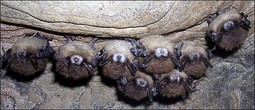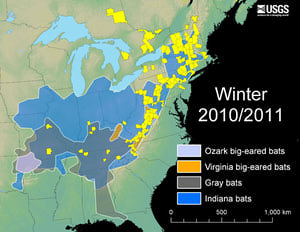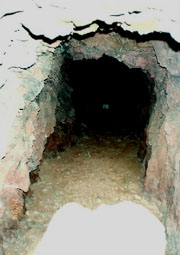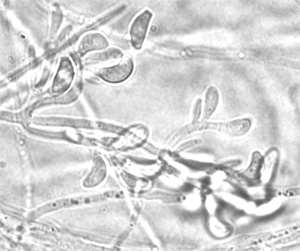White nose syndrome in bats: Difference between revisions
| Line 41: | Line 41: | ||
<br> | <br> | ||
== | ==Key Microorganisms== | ||
What | [[Image:Geomyces.png|thumb|300px|right|Scanning electron micrograph of <i>Geomyces destructans</i>. Image courtesy of David Blehert, USGS, National Wildlife Health Center.]] | ||
What specific kinds of microbes are typically involved in this interaction? Or associated with important processes? | |||
Are some of the groups of microbes from your environment already described? Create links to other MicrobeWiki pages where possible. | |||
===<br><i>Geomyces destructans</i>=== | |||
[http://en.wikipedia.org/wiki/Geomyces_destructans] | |||
<i>Geomyces destructans</i> the fungi from the class Leotiomycetes and in the phylum Ascomycota. This fungus forms conidia and conidiospores on the faces, ears, and wings of the bats. <i>Geomyces destructans</i> cannot function at temperatures higher than 24 degrees C (75 degrees F) but thrive in temperatures ranging from 4 – 15 degrees C (39 – 59 degrees F). <i>Geomyces destructans</i> has a similar temperature range as that of winter hibernacula of North American bats. | |||
===North American Bats=== | |||
====Little Brown Bats (<i>Myotis lucifugus Le Conte</i>)==== | |||
[http://en.wikipedia.org/wiki/Little_brown_bat] | |||
One of the most common bats in North America. Little brown bats are found in almost all of North America. Little brown bats are insectivores. This organism is also nocturnal and it leaves its roost after dusk and before dawn. Now that Geomyces destructans is prevalent in many Northeastern caves, this species population numbers is dwindling. | |||
====Northern Long-Eared Bats (<i>Myotis septentrionalis Trovessart</i>)==== | |||
[http://en.wikipedia.org/wiki/Northern_long-eared_myotis] | |||
This species is fairly small in size but has relatively long ears. This species is dispersed along the eastern coast of the United States. Northern long-eared bats are also nocturnal and insectivorous. | |||
====Big Brown Bats (<i>Eptesicus fuscus Beauvois</i>)==== | |||
[http://en.wikipedia.org/wiki/Big_brown_bat] | |||
This species is the largest amongst these four species. The big brown bat is nocturnal and hunts insects at dusk and dawn. Big brown bats are common across the United States. | |||
====Tri-colored Bats (<i>Perimyotis subflavus Menu</i>)==== | |||
[http://en.wikipedia.org/wiki/Eastern_Pipistrelle] | |||
Tri-colored bats are commonly found throughout the eastern parts of the United States. This bat, along with the other three species, has a conservation status of “least concern.” Tri-colored bats are also nocturnal and insectivorous. | |||
<br> | <br> | ||
Revision as of 06:11, 29 March 2012
Introduction
Other examples:
Bold
Italic
Subscript: H2O
Superscript: Fe3+
Introduce the interaction, the organisms involved, the ecological significance of this interaction, and the importance of microorganisms and their processes in this environment (described in more detail below).
White Nose Syndrome in bats is a rapidly spreading disease occurring in hibernating bats during the winter months in caves and mines. A fungus called Geomyces destructans, which influences the bat to conduct unusual, perilous behavior during hibernation, causes White Nose Syndrome. Geomyces destructans produces reproductive spores, conidia, on the bats wings and mouth. Since 2006, Geomyces destructans has spread in caves and mines in over 16 states and 4 Canadian provinces. [1] As of January 2012, between 5.5 and 6.7 million North American bats have perished from White Nose Syndrome (US Fish & Wildlife Service 2012). As bat populations decrease, certain environmental processes will be impacted such as an increase of insects, particular plants will not be pollinated, and a decrease in seed dispersal. Geomyces destructans inhibits natural bat behavior which in turn adversely affects environmental processes. In this interaction, Geomyces destructans has a negative effect on the environment and environmental processes.
Biological interaction
Provide details of the symbiosis or biological interaction. Is this a specific or general interaction? How do these interactions influence the host or other microbial populations, and their activities? How do these interactions influence other organisms (positive or negative influences)? What is the outcome of this interaction? Are there ecological consequences?
Describe biological interactions using as many sections/subsections as you require.
Parasitoidism
The biological interaction between Geomyces destructans and North American bats could be thought of as parasitoidism. [2] Parasitoidism differs from parasitism in that the parasitoid kills its host. Geomyces destructans quickly covers parts of the bat’s body and tissues and impacts body fat storage, resulting in the death of the infected bat. Geomyces destructans affects the bat’s typical hibernation behavior, bats store fat so that during the winter months, the bat has enough energy to survive on while hibernating. During hibernation, the bat wakes up and flies out of the cave and into the cold winter weather in search of food. To no avail, the bat finds no food and wastes some of its body fat storage. Similarly, infected bats choose to huddle near entrances of caves and mines (areas that still receive some light) during hibernation whereas normal, uninfected bats hibernate deep in caves and mines away from harsh, cold temperatures. Geomyces destructans negatively impacts North American bats by disturbing their normal winter sleeping period and causing a decreased ability to survive the winter. Geomyces destructans is a silent killer; it attacks when the bats immune system is at its lowest; while the bat is unaware of the infection.
Niche
Bats inhabit places where little human interaction occurs. Organisms living deep in caves or abandoned mines have acquired adaptations such as lack of pigmentation, increased sensory structures, reduced eyes or blindness, low reproductive rates, and elongated appendages and antennae. Organisms living in caves must be accustomed to continuous darkness, constant temperatures, and high humidity.
Describe the chemical, or spatial characteristics of the niche where we might find this interaction, using as many sections/subsections as you require. Look at other topics available in MicrobeWiki. Create links where relevant.
Caves
[3] Bats cling to ceilings and walls of the cave. Most caves have water, fish, crayfish, crickets, other insects, bats and any organism that enjoys steady temperatures ranging from 39 – 59 degrees Fahrenheit.
Abandoned Mines
Old mines have an entrance/exit point where the bats can fly out. Inside the old mine, the temperature stays pretty constant like a cave unlike the fluctuating temperatures outside. Also, abandoned mines are dark and stay cool throughout the year, which is a key requirement for nocturnal creatures like bats.
Key Microorganisms
What specific kinds of microbes are typically involved in this interaction? Or associated with important processes? Are some of the groups of microbes from your environment already described? Create links to other MicrobeWiki pages where possible.
Geomyces destructans
[4] Geomyces destructans the fungi from the class Leotiomycetes and in the phylum Ascomycota. This fungus forms conidia and conidiospores on the faces, ears, and wings of the bats. Geomyces destructans cannot function at temperatures higher than 24 degrees C (75 degrees F) but thrive in temperatures ranging from 4 – 15 degrees C (39 – 59 degrees F). Geomyces destructans has a similar temperature range as that of winter hibernacula of North American bats.
North American Bats
Little Brown Bats (Myotis lucifugus Le Conte)
[5] One of the most common bats in North America. Little brown bats are found in almost all of North America. Little brown bats are insectivores. This organism is also nocturnal and it leaves its roost after dusk and before dawn. Now that Geomyces destructans is prevalent in many Northeastern caves, this species population numbers is dwindling.
Northern Long-Eared Bats (Myotis septentrionalis Trovessart)
[6] This species is fairly small in size but has relatively long ears. This species is dispersed along the eastern coast of the United States. Northern long-eared bats are also nocturnal and insectivorous.
Big Brown Bats (Eptesicus fuscus Beauvois)
[7] This species is the largest amongst these four species. The big brown bat is nocturnal and hunts insects at dusk and dawn. Big brown bats are common across the United States.
Tri-colored Bats (Perimyotis subflavus Menu)
[8] Tri-colored bats are commonly found throughout the eastern parts of the United States. This bat, along with the other three species, has a conservation status of “least concern.” Tri-colored bats are also nocturnal and insectivorous.
Key Microorganisms
What specific kinds of microbes are typically involved in this interaction? Or associated with important processes? Are some of the groups of microbes from your environment already described? Create links to other MicrobeWiki pages where possible.
Geomyces destructans
[9] Geomyces destructans the fungi from the class Leotiomycetes and in the phylum Ascomycota. This fungus forms conidia and conidiospores on the faces, ears, and wings of the bats. Geomyces destructans cannot function at temperatures higher than 24 degrees C (75 degrees F) but thrive in temperatures ranging from 4 – 15 degrees C (39 – 59 degrees F). Geomyces destructans has a similar temperature range as that of winter hibernacula of North American bats.
North American Bats
Little Brown Bats (Myotis lucifugus Le Conte)
[10] One of the most common bats in North America. Little brown bats are found in almost all of North America. Little brown bats are insectivores. This organism is also nocturnal and it leaves its roost after dusk and before dawn. Now that Geomyces destructans is prevalent in many Northeastern caves, this species population numbers is dwindling.
Northern Long-Eared Bats (Myotis septentrionalis Trovessart)
[11] This species is fairly small in size but has relatively long ears. This species is dispersed along the eastern coast of the United States. Northern long-eared bats are also nocturnal and insectivorous.
Big Brown Bats (Eptesicus fuscus Beauvois)
[12] This species is the largest amongst these four species. The big brown bat is nocturnal and hunts insects at dusk and dawn. Big brown bats are common across the United States.
Tri-colored Bats (Perimyotis subflavus Menu)
[13] Tri-colored bats are commonly found throughout the eastern parts of the United States. This bat, along with the other three species, has a conservation status of “least concern.” Tri-colored bats are also nocturnal and insectivorous.
Current Research
Experimental infection of bats with Geomyces destructans causes WNS
This article suggests there is evidence lacking that Geomyces destructans is the primary source of white-nose syndrome. Also, Lorch et al state that many assume that all fungal infections are commonly connected with immune system dysfunction. Finally, Geomyces destructans is commonly found on European bats’ skin but there are no large bat mortality occurrences that have led scientists to believe that Geomyces destructans is not the sole cause of white-nose syndrome.
White-nose syndrome threatens the survival of hibernating bats in North America
The USGS has compiled information concerning five species of bats: little brown bats, northern long-eared bats, Indiana bats, big brown bats, and tricolored bats. White-nose syndrome had suddenly and rapidly become widespread. Geomyces destructans has played a major role in the swift decrease in bat populations on the northeastern coast.
White-nose syndrome: is this emerging disease a threat to European bats?
Geomyces destructans was found to affect North American bat populations starting in 2006. It was not until 2009 that Geomyces destructans was found to pose a threat in Europe. This article explains the planning of multiple countries trying to gain more information about white-nose syndrome and whether or not it will lead European bats to a similar outcome of North American bats.
References
Jahn, E., 2011 "Mysterious Killer: White Nose Syndrome Threatens Bat Population"
Mineral Information Institute - Institute that is focused on mine reclamation projects <http://www.mii.org/Rec/socorro/socorro.html>
Journey Into Amazing Caves - A educational film series that provides basic information about caves <http://www.amazingcaves.com/set_learn_ecology.html>
Forays Into Fungal Genomics - A Broad Institute of MIT and Harvard <http://www.broadinstitute.org/what-is-broad/areas-focus/project-spotlight/forays-fungal-genomics>
For More Information, please visit this link!
Edited by Rachel Luttrell, a student of Angela Kent at the University of Illinois at Urbana-Champaign.




